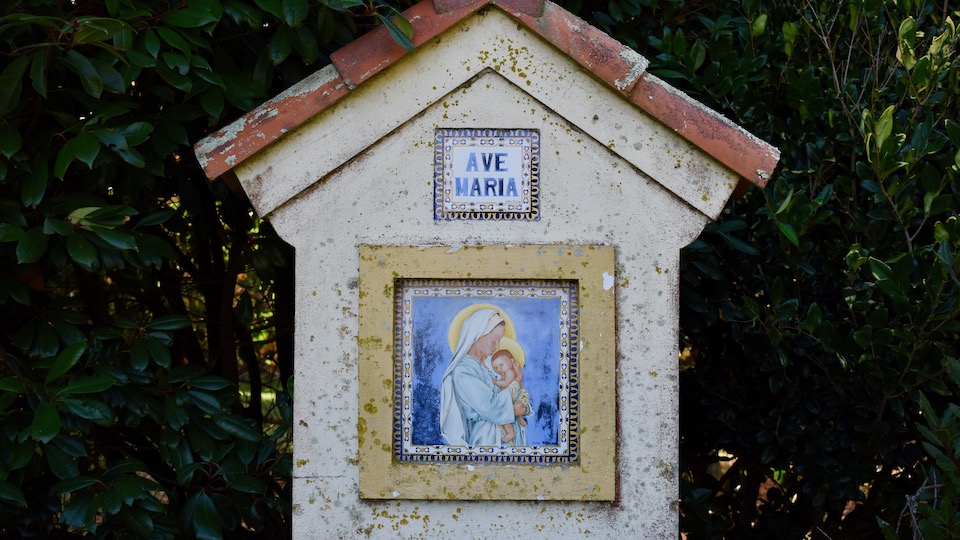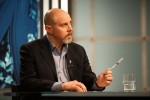

Deacon-structing: What is the Hail Mary?
Deacon Pedro
Saturday, May 6, 2023

Photo by Emilio Llorente on Cathopic.
“Blessed are you among women…” (Luke 1:42)How many times have we said those words? Thousands of times, maybe not even thinking about what we’re saying. As you might know, I grew up in Latin America, where there is a huge cultural devotion to Mary. (I wrote some more about Marian traditions in Latin America in Deacon-structing Mary - Part 5: Mary in the Americas.) For that reason, I didn’t grow up with a great devotion to Mary. It seemed a little superstitious, and didn’t make much sense. I thought, "why should I go to Mary, why should I pray to Mary, when I can just go straight to Jesus?" I thought that we called Mary blessed – blessed are you among women – because she’s a saint. All the saints are blessed. I mean she is the saint of all saints; she was chosen to be the mother of the Son of God, but I still thought she’s blessed because she’s a saint. Why does Elizabeth greet her and say that she is blessed? “Blessed are you among women and blessed is the fruit of your womb…Blessed are you who believed that the promise that was spoken to you would be fulfilled” (Luke 1:42, 45). Mary herself, in the Magnificat – the prayer that she prays as a response to Elizabeth’s greeting – then says, “from this day all generations will call me blessed” (v. 48).
And it’s true: Up to this generation we still call her blessed. But why?
I didn’t understand that the reason why we call Mary blessed has to do with those other few words that we also say all the time when we say that prayer: “Hail Mary, full of grace. The Lord is with you.” How many times have we said those words? The angelic salutation, we call it. Why does the Angel Gabriel greet Mary with those words? “Hail Mary, full of grace. The Lord is with you” (Luke 1:28). Hail, full of grace. He calls her full of grace, almost as if that was her name: “Hail. Greetings, full of grace. The Lord is with you.” Why is Mary full of grace? We have to ask ourselves, who else was full of grace – other than Jesus of course – who else? Who were the other two people, who at one point, were full of grace? Adam and Eve. Adam and Eve were created full of grace, before original sin. The Lord was with them before original sin, and so we can say with confidence that if Mary is also full of grace, then Mary was also conceived, as if she was created, before original sin. She was conceived without sin. That’s why we call her the Immaculate Conception. She was not conceived before original sin, but she is conceived without sin. That’s what it means that she is full of grace. And because she is full of grace, the Lord can be with her. The Lord can be completely united with her. She can be completely full of the Lord so much so that she is, literally, pregnant with God. That’s what it means that the Lord is with her: that she is so completely united with God that she becomes the spouse of God, the Holy Spirit, and the Holy Spirit can conceive within her the Son of God, who is God.Hail Mary, full of grace. The Lord is with you. Blessed are you among women and blessed is the fruit of your womb.
Because Mary is conceived without sin, because she is full of grace, because she is the Immaculate Conception, she does not suffer the consequences of sin. St. Paul tells us that "the wages of sin is death" (Romans 6:23). Death does not enter the world until original sin enters the world, until the fall of Adam and Eve. So Mary, conceived without sin, full of grace, does not suffer the consequences of sin. We can say with confidence that Mary did not suffer death, but at the end of her earthly existence she was assumed, body and soul into heaven, "where God," as we read in the Book of Revelation 12:6, “has prepared a place for her,” where she shares in the glory with Jesus Christ. (Learn more about the Dogma of the Assumption in Deacon-strucing Mary – Part 2: The Assumption.)The fact that Mary is blessed doesn’t mean that she is set apart from us.
She is blessed, because God has chosen her to lead the way where we are meant to go as well. Mary shares in the Glory of the Resurrection, body and soul, because that’s also where we are going. St. Paul tells the Corinthians that Jesus Christ is the “first fruits of those who have fallen asleep” (1 Corinthians 15:20). That is because He is the first one to be risen. But then Paul continues to say that Jesus is the first one, the first fruits, and the rest will follow. We are the rest who will follow. We also will rise at the end of time with the second coming when death is no more. Mary was the second one. She doesn’t have to wait until the end of time, and she doesn’t have to be risen again, because she didn’t die. She already shares in that glory, so that she can show us the way. Mary is the example of the fulfillment of that promise that is made to all of us: that we too can share in that same glory, body and soul. That’s why when we say the Creed, we say that we "believe in the resurrection of the body." We will be resurrected with our bodies: maybe not these earthly bodies, but with perfected bodies. Jesus and Mary are in heaven, body and soul, not just soul. We will be in heaven with our completed bodies. Our bodies are not deleted in heaven; they are completed in heaven. Mary is blessed because she gets to be the second one to share in that glory, and she gets to show us the way. She is blessed because she gets to be our guide.That's what the Hail Mary is all about.
That's why we ask Mary to pray for us. The first half of the Hail Mary are the words of the Angel and the words of Elizabeth. The second part is how we respond to those words: We ask Mary, the Mother of God, to pray for us, especially at the time of death, so we can enjoy the glory of heaven, like she does, with Jesus! People have been praying the words of the Angelic Salutation and the words of Elizabeth since as far back as the 4th century. In the 6th century it appears in several liturgies, such as the Liturgy of St. James: “Hail, Mary, highly favoured: the Lord is with You; blessed are you among women, and blessed the fruit of your womb, for you bore the Saviour of our souls” In the 7th century it is found in the Liturgy of the Feast of the Annunciation and during the Season of Advent. But it isn’t until around the 11th century that the prayer becomes a popular devotion, when the practice of reciting these two verses as responses is developed in the "Little Office of the Blessed Virgin Mary" in monastic communities. The second part of the prayer is not developed until between the 13th and 14th centuries: St. Dominic promotes the praying of the Rosary in the 13th century (Find out more about St. Dominic and the Rosary in Deacon-structing Mary - Part 3: The Rosary.) The current form of the "Hail Mary" was introduced in various religious communities' Breviaries in the 15th century. People have been meditating on the words of Scripture and asking for Mary's prayers with these same words for a long time.Asking Mary to be our guide has been part of our Faith for a long time.
Who better to be our guide than a woman, a mother, a human being who’s been through many of the same struggles that you have been through and that you are going through? Mary prays the Magnificat, and extols all the great things that God has done: “He has mercy on those who fear him in every generation; He has shown the strength of his arm. He has scattered the proud in their conceit; He has lifted up the lowly he has cast down the mighty from their thrones” (Luke 1:50-52). She’s not just talking about some things that God has done in the past. She’s talking about her own experience. She lived it: “for the almighty has done great things for me” (v. 49), she says. She was an unwed pregnant teenager. She went through a difficult birth, under very difficult circumstances, subjected to an oppressive regime that demanded that they travel to some little town and go through a census, and then had to escape a massacre of children with her husband and her child to live as a refugee in a foreign country, and then lived in lowliness and obscurity in a small town. She survived the death of her husband – probably while she was still young – and then lived through the unjust treatment of her son, his unjust arrest and trial. And she survived the death of her own son. If you are going through anything remotely close to any of those situations, go to Mary, because she knows what it’s like. If you are feeling alone or you’re feeling abandoned, if you’re feeling persecuted or you’re feeling or feeling imprisoned, go to Mary, because she is your mother, your tender mother who knows what you are going through and who wants nothing more than to bring you to her son, Jesus. If you want to go to Jesus, go through Mary, because the quickest way to get to Jesus is through Mary, his mother, who wants nothing more than to bring you to her son Jesus. And it is as simple as starting with those words that we say all the time, sometimes, not even thinking about what we’re saying. It doesn’t matter. Say them often.Hail Mary, full of grace, the Lord is with thee. Blessed art thou amongst women, and blessed is the fruit of thy womb Jesus. Holy Mary, Mother of God, pray for us sinners now and at the hour of our death. Amen.Learn more about Mary. Read Deacon-structing: Part 1: Full of Grace Part 2: The Assumption Part 3: The Rosary Part 4: Apparitions Part 5: Mary in the Americas
Related Articles:
<<














